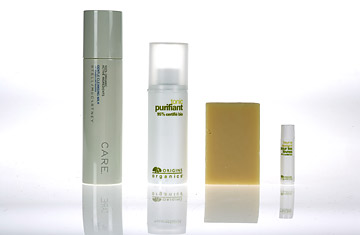
From left to right: Gentle Cleansing Milk from Care by Stella McCartney; Purifying Tonic, Cleansing Body Bar, and Soothing Lip Balm from Origins Organic.
(2 of 2)
So what does it mean when the organic lemon in your kitchen is cultivated under the same conditions as the ingredients in the organic soap in your shower? For starters, it's the best assurance you can get that your organic beauty products—and the packaging they come in—are formulated from food-grade organic raw materials. The NOP logo certifies that the ingredients, whether tea-tree oil or rosemary, were grown on organic farms that are pesticide-free, from plants that were not genetically modified and on plots of land that, for at least three years, have not nurtured nonorganic crops grown with synthetic pesticides and other agricultural agents. Growers must also be vigilant about airborne contaminants—ensuring that wind doesn't blow any nonorganic seeds onto the organic farm. Organic plants must also be protected from potential exposure to sewer sludge, a possible source of contamination from synthetic goods.
Once in the factory, organic products must be processed on dedicated machinery and cleaned with environmentally safe products. "It took us three years to convert manufacturing for our organic products," says Mazzella, of Origins' USDA-certified line, "and two years to come up with new formulas for them."
Even the USDA label, however, requires that only 95% of the ingredients in an organic product be organically grown. And the remaining 5%? Those agents may be nonorganic, but they must still come from materials on the NOP list, which include mostly natural components such as vitamin E as a stabilizer and citric acid to balance pH, neither of which can be found or produced in a completely organic form yet.
Products with less than 95% of organic ingredients can still claim to be organic, at least in part—but they are no longer eligible for USDA certification. If products contain from 70% to 94.9% of organic elements, for example, their labels can claim that they are made with organic materials. Any beauty concoction with less than 70% organic content can only indicate, generally in the ingredients list, the specific agents that are certified organic. Neither product can use the USDA-certified organic logo.
So is all this label-scouring worth the trouble? That depends. If you're organic-obsessed and demand that your shampoo be as environmentally conscious as your chicken, then looking for the NOP logo will certainly put your mind at ease. But if you are choosing organic products because you believe that natural products are better for your skin and body, you may want to consider this: "Any benefits are sure to be incremental at best," says Dr. Alexa Kimball, a dermatologist at Harvard Medical School. "Typically, there is some research somewhere that boosts up a claim about the benefits of organic agents, but whether it was done in a study that doctors would consider valid is a whole different scenario." Plus, she and other experts note, nonorganic cosmetics are relatively safe. Just because something is made in a lab does not mean it's bad for your body. In fact, many natural and organic ingredients come in oil form, and there are people who cannot tolerate these oils regardless of how "pure" they are. "Take aloe, which may be organic and come right from the plant but is a sensitizer," says Dr. Deborah Sarnoff, of New York University. "There is a percentage of the population who are allergic to it when they put it on their skin."
Another key feature of organic products is their shorter shelf life. Because they are made with natural ingredients and essential oils as preservatives, organic cosmetics generally have half the shelf life of nonorganic formulas. In the end, say the cosmetics manufacturers, the choice is the consumer's. "If the consumer wants organic products, we will give them organic products," says Sylvie Raynal, director of research and development at Sothy's, a French beauty company that is readying an organic line set to include a cream, cleanser and toner, all certified by EcoCert. "But they must be organics that are certified and are well tolerated by the consumer." Without that, no amount of marketing would make any difference.